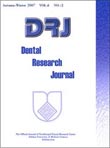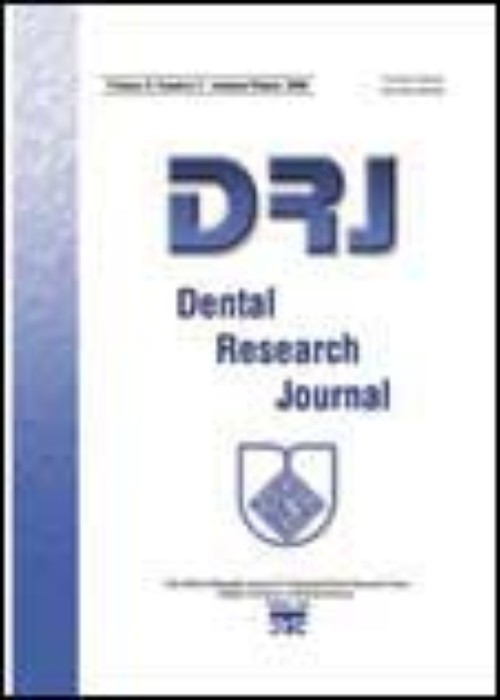فهرست مطالب

Dental Research Journal
Volume:4 Issue: 1, Jan 2007
- تاریخ انتشار: 1386/10/01
- تعداد عناوین: 8
-
Page 4Introduction:Malignant salivary glands tumors (MSGTs) are uncommon cancers. The most com-mon site of these cancers is the parotid gland. Some investigations show these cancers preference for males than females. The majority of MSGTs arise in sixth decade of human life. According to the literature review for the present work, there is a few epidemiological researches about MSGTs in Iran and especially there isn''t any study in Kerman province. So the aim of this study was investi-gation the incidence, sex, age, histological types, and site distribution of MSGTs in the Kerman province during the time period from March 1991 to March 2002.
Methods and Materials:Documents and records of 70 patients with MSGTs diagnosed from March 1991 to March 2002 were reviewed. The patients'' records were analyzed based on gender, age, loca-tion, and histopathological type of the tumor. Data were analyzed by SPSS-13.5 statistical software using t-test, chi-square, and ANOVA tests.
Results:During this period of time, 70 cases (43men, 27 women) of MSGTs had been diagnosed. Mucoepidermoid carcinoma was the most common cancer (30%) and the parotid was the most af-fected site (70%). The age range was 10-86 years old with the overall mean age of 50.18 ± 17.97.
Discussion:Despite a considerable volume of literatures written about MSGTs in many countries, the incidence of these cancers haven''t as yet been thoroughly documented or analyzed in Iran. How-ever, comparison between the findings of this study with the results of other investigations showed a relative consistency.Keywords: Salivary Glands, Malignant, Kerman -
Page 11Introduction
Oral local immune factors may play a protective role against oral diseases and defend against microbial agents. Salivary immunoglobulin A (IgA) is a major factor for the local host de-fence against caries and periodontal disease. The aims of this study were to determine the concen-trations of salivary IgA and IgE levels in breast-fed and formula-fed children in infancy period.
Methods and Materials
Totally, 80 healthy 5 years old children were included in the study. Ac-cording to type of feeding in infancy period, the children divided into two groups: 50 breast-fed and 30 formula-fed. One milliliter of saliva was collected from each participant, centrifuged, and stored at -70 ˚C. The salivary IgA and IgE concentrations were measured, using ELISA technique.
Results
In breast-fed children, the salivary IgA level (39.6 mg/l ± 17.3) was significantly higher than that in formula-fed children (26.9 mg/l ± 14) (P=0.0001). However, the salivary IgE level was significantly lower in breast-fed children, comparing with formula-fed ones (5.01 IU/ml ± 19.70 vs. 11.74 IU/ml ± 39.40) (P=0.047).
Discussion
These results suggest that breast feeding enhances salivary IgA level in the early period of life which may contribute in oral cavity immunity. Higher salivary IgE level observed in for-mula-fed subjects may have a potential role in development of allergic or inflammatory reactions.Keywords: Breast Feeding, Formula Feeding, Saliva, IgA, IgE, Children -
Page 18Introduction
Despite the fact that oral and perioral cancers are not included in common cancers, they are of special importance for their impact on human morbidity and life quality. Awareness of the epidemiological characteristics of oral cancers allows for enhanced planning of timely and effec-tive treatment in order to improve patients’ life quality. The objective of the present study was to investigate the distributional patterns of oral and perioral malignancies in terms of age, gender, type, and location.
Methods and Materials
4553 oral biopsy specimens taken over 17 years (1988-2004) at the De-partment of Oral and Maxillo-Facial Pathology, Faculty of Dentistry, Isfahan University of Medical Sciences, were studied. Among these, 283 cases included oral malignant lesions. The age, gender, location, and type of malignancy data for these cases were recorded.
Results
The results of this survey showed that commoner malignant oral lesions were epithelial le-sions with 175 cases (62%), salivary lesions with 48 cases (17%), and hematogenic malignancies with 23 cases (9%). Squamous cell carcinoma, mucoepidermoid carcinoma, lymphoma, and os-teosarcoma were the commoner malignant lesions in this area of the body. The mean age of patients was 52.2 years of old and the male to female ratio was found to be 1.3.
Discussion
The present study showed that compared to the less common malignant lesions, the more common ones, i.e. epithelial and salivary lesions, show far more differences from those re-ported in previous studies. For example, compared to previous studies, the mean age for epithelial lesions was found to be less by one decade while the mean age for salivary gland lesions was found to be higher by one decade. Squamous cell carcinoma (SCC) was found to be the most common ma-lignancy but its relative frequency was lower than that reported in previous studies. Moreover, dif-ferences were also observed in its anatomical distribution. Lip, salivary gland, and maxillary malig-nant lesions were less common than expected, which is probably due to their extra oral clinical characteristics. The results of the present study also showed that lesions with relatively lower fre-quencies are more similar to those reported in previous studies.Keywords: Oral Cancer, Epidemiological Characteristics -
Page 26Introduction
The penetration of irrigating solution to the apical one third of canals and removal of debris are dependent on the final size of the instruments and instrumentation techniques used in the canals. The purpose of this study was to evaluate the effect of final instrument size, on irrigation penetration into the apical part of canals in hand K-file instrumentation versus rotary system of Hero 642.
Methods and Materials
The mesiobuccal canals of 48 first mandibular molar teeth were selected for this study. The teeth were divided into 2 groups of 24 in each and the mesiobuccal canals were instrumented by hand K-file or rotary system of Hero 642 at 2 stages. After each stage, a contrast medium was injected into the canals and radiographs were taken by RVG system. The irrigation penetration was measured in radiographs by Diamax software. The data were analyzed using t – student test.
Results
This study showed that instrumentation up to # 25 file is not enough for irrigation penetra-tion into the apical area. Also by more flaring the canals, more irrigating solution penetrates into the apical part of canals (P ≤ 0.001), but the difference between hand and rotary systems was not statis-tically significant (P > 0.05).
Discussion
According to this study, instrumentation up to # 30 file results in better irrigation pene-tration into the apical area. The flaring of the canals is essential for better cleaning and irrigation of apical area.Keywords: Cleaning, Filing, Flaring, Irrigation penetration, Master Apical File -
Page 30Introduction
Use of fluoride tablet is one of the several ways of fluoridation in children. The pur-pose of this study was to evaluate the systemic absorption of fluoride from a generic sodium fluo-ride tablet, in comparison with a commercial one.
Methods and Materials
This was a double-blind, cross over study. Following ingestion of 1 mg of fluoride in a generic or commercial form, urine samples were collected from 27 healthy boys aged 8-10 years old over a 24-hour period. The urine samples were analyzed by potentiometeric method using fluoride ion selective electrode.
Results
Under the identical conditions, the mean 24-hour urinary fluoride excretion rate of the sub-jects before taking any generic and commercial fluoride tablets were 15.87±4.68 and 17.51±6.40 g/hr, respectively. The average rates of 24-hour urinary fluoride excretion of the subjects were 25.74±6.75 and 28.21±9.23 g/hr after the ingestion of generic and commercial fluoride tables, re-spectively. The mean cumulative amounts of fluoride ion excreted in 24-hour urine collection were 28% and 22% of the administered doses of commercial and generic fluoride tablets, respectively.
Discussio
Results indicated that the systemic absorption of the fluoride ion released from the ge-neric tablet is not significantly different from the commercial one. Therefore, it can be suggested that the tested generic tablets is bioequivalent to the commercial ones.Keywords: Systemic Absorption, Children Sodium Fluoride Tablet -
Page 36Introduction
The purpose of this study was to evaluate the effect of thermo-cycling and curing mode of composites (light and chemical curing) on dentin bond strength of one all-in-one and an one-bottle bonding systems.
Methods and Materials
Occlusal enamels of eighty caries-free third molars were ground with a model trimmer to create flat surfaces in superficial dentin for bonding, and randomly divided into 4 groups. Teflon molds with 1 mm internal diameter were mounted on the flat surfaces, Prompt L-pop (all-in-one system) (3M-ESPE) and Single-Bond (one-bottle system) (3M-ESPE) were used and re-stored with FiltekZ250 (light-cured composite) (3M-RSPE) and Concise (chemically cured compos-ite) (3M-ESPE) composites. Specimens were stored in 37°c distilled water for 24 hours. 10 speci-mens of each group were thermo-cycled 500 times between 5°c to 55°c. Micro- shear bond strength test was done with 0.5mm/min crosshead speed (Dartec, England). The data were analyzed by ANOVA and Duncan''s tests.
Results
The mean shear bond strengths of two adhesive systems with light-cured composite showed no significant differences with and without thermo-cycling (P -
Page 40Introduction
Fluid composites have been suggested as gingival layer beneath class II composite restorations to improve marginal integrity and reduce microleakage. This in-vitro study evaluated the influence of fluid composites as gingival layer on microleakage of class II packable, microhy-brid, and fiber-reinforced composite restorations with the margins below the cementoenamel junc-tion (CEJ).
Methods and Materials
45 sound premolars extracted for orthodontic reasons were selected. Class II cavities were prepared on the mesial and distal aspects with the gingival margin placed 1 mm be-low the CEJ, making 90 slot cavities. Teeth were randomly assigned into 3 groups (n=15). In each group, one side of each tooth was restored incrementally with respective packable, microhybrid, and fiber-reinforced composites; whereas, on the other side, fluid composite was placed as a 1 mm thickness gingival increment before restoration with the same composites. The teeth were stored for one week in distilled water at 37 C, thermo-cycled (5-55 C, x 1500), and immersed in 0. 5% basic fuchsine for 24 hours. Dye penetration was evaluated using a stereomicroscope at 10x magnification. The data were analyzed statistically by Kruskal-Wallis analysis of variance and Mann-Whitney U-test.
Results
The fluid composite reduced microleakage at gingival margins of Class II restorations (P -
Page 48Introduction
The aim of this in vitro study was to compare the antimicrobial activity and substan-tivity of three concentrations of doxycycline on bovine root dentin infections.
Methods and Materials
Seventy dentin tubes prepared from intact bovine incisors were infected in vitro for 14 days with Enterococcus faecalis. The specimens were divided into five groups accord-ing to the used intracanal irrigation as follows: Group1: l00mg/ml of doxycycline hydrochloride so-lution (DHS) (n=20); Group 2: 50mg/ml of DHS (n=20); Group 3: 10mg/ml of DHS (n=20); Group 4: positive control (infected dentin tubes) (n=10); and Group 5: sterile saline (negative control) (n=10). Dentin chips were removed from the canals with sequential sterile low - speed round burs with increasing diameters of ISO sizes: 025, 027, 029, 031, and 033 at experi-mental times of 0, 7, 14, 21, and 28 days. After culturing, the numbers of colony-forming units (CFUs) were counted. Data were analyzed using analysis of variance and covariance with repeated measures (ANOVA) to indicate differences between the experimental groups and the positive control. One-way ANOVA (Tukey''s method) was used to indicate differ-ences within each layer.
Results
The numbers of CFUs in all three experimental groups were minimum in first cultures, and the obtained results were significantly different from each other at any time period (P


